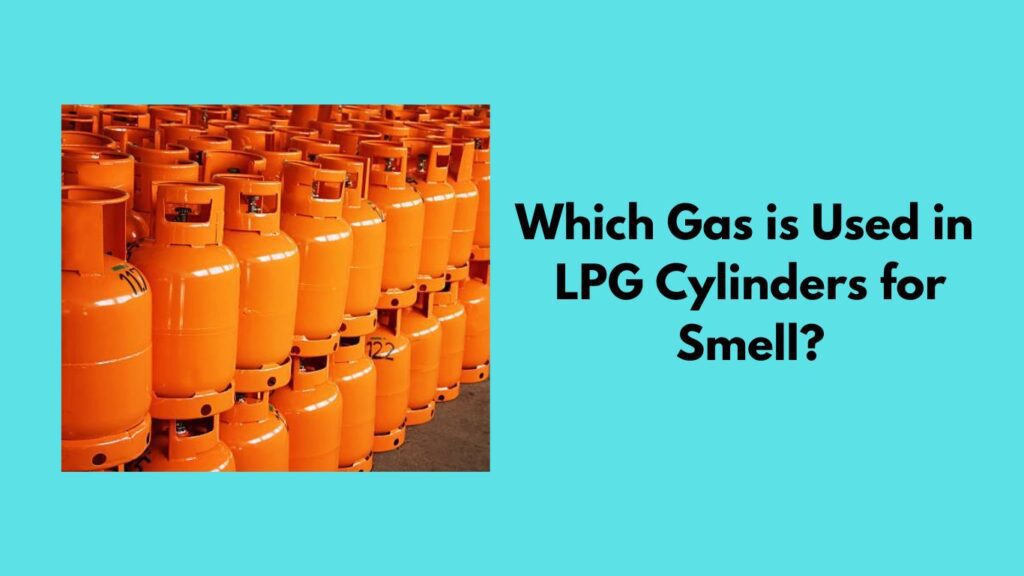LPG, or liquefied petroleum gas, is a versatile fuel that is widely used in homes and businesses for cooking, heating, and other purposes. It is a mixture of propane and butane gases that are compressed and stored in steel cylinders for easy transport and use. Although LPG is a clean and effective fuel, a leak can be hazardous because it is highly flammable and can result in explosions. A potent odorant is added to the gas before it is bottled in order to deter accidents and warn people of the presence of LPG. The gas used in LPG cylinders for smell and the rationale behind its necessity will be discussed in this article.

Typically, ethanethiol, also known as ethyl mercaptan, is used as the odorant in LPG. This colourless gas has a strong, pungent aroma that is comparable to that of rotten eggs or skunk spray. Natural gas, propane, and other flammable gases frequently contain ethane thiol as a warning agent because it is created when ethylene reacts with hydrogen sulphide. It is used to give LPG its distinct smell in very small amounts—typically less than 1% by volume.
Ethanethiol is added to LPG to facilitate leak detection and accident prevention. Due to its lack of colour and smell, LPG can be hard to detect when it escapes from a cylinder or pipeline. This poses a particular risk in enclosed areas where LPG can build up and produce a flammable environment. Due to the addition of ethanethiol to LPG, even tiny leaks can be detected by the odour, enabling people to act quickly to avert an accident.
International standards govern the use of odorants in LPG to guarantee consistency and safety. The ISO 13760 standard, which outlines the specifications for odorants used in LPG and natural gas, is the most widely accepted one. A minimum detectable odour concentration (MDOC) of 5 parts per million (ppm) and a maximum detectable odour concentration (MOC) of 20 ppm are required for the odorant used in LPG, respectively, by ISO 13760. This makes sure that the smell is discernible but not so overpowering or unhealthy that it could be harmful.
The most widely used odorant in LPG is ethane thiol, though other substances may be used in some nations or regions. For instance, ethanethiol, propane, and butane are frequently combined in the US to produce a more complex odour that is simpler to detect. Instead of using ethanethiol alone, some European nations combine it with dimethyl sulphide. The odorant selected may be influenced by elements like cost, accessibility, and regional laws.
While adding odorants to LPG is necessary for safety, doing so can present some difficulties. If there is a leak or spill, the unpleasant and potent smell of LPG may linger in residences or commercial buildings. Additionally, some individuals may be more sensitive to the smell than others and may exhibit other symptoms such as headaches or nausea if exposed to high concentrations of the odorant. It’s critical to handle LPG with care, store it properly, and act quickly if a leak is discovered to address these issues.
Ethanethiol, or ethyl mercaptan, a colourless gas with a potent aroma, is the odorant used in LPG cylinders. Small amounts of it are added to LPG to give the gas its distinctive smell and make leak detection easier. International standards govern the use of odorants in LPG to guarantee consistency and safety.
Since LPG is a colourless and odourless gas, it can be challenging to detect when it escapes from a cylinder or pipeline, making the addition of ethanethiol to LPG essential for safety. Ethanethiol has a potent smell that makes it possible to detect even small leaks and prompts people to act right away to avert an accident.
However, if there is a leak or spill, the potent LPG odour may be unpleasant and linger in residences or commercial buildings. Some people may also be more sensitive to the smell than others, and they may exhibit other symptoms such as headaches if exposed to high concentrations of the odorant. It’s important to handle LPG with care, store it properly, and act quickly if a leak is discovered to address these issues.
The cylinders should be kept upright, secured to prevent them from falling, and stored in well-ventilated areas far from potential ignition sources. These are all proper handling and storage practises for LPG. Additionally, LPG cylinders should be regularly inspected for leaks and damage, and any problems should be resolved right away. Additionally, it’s critical to use LPG appliances correctly and adhere to all installation, use, and maintenance guidelines provided by the manufacturer.
If a leak is found, it must be fixed immediately to prevent an accident. The gas supply need to be turned off, the area need to be cleared, and a professional may need to be contacted to fix the leak. Additionally, if there is a chance of a fire or explosion, call the emergency services and evacuate the area if necessary.
The gas used in LPG cylinders for smell is ethanethiol or ethyl mercaptan. To make it simpler to find leaks and avoid accidents, it is added to LPG in tiny amounts. International standards govern the use of odorants in LPG to guarantee consistency and safety. LPG handling and storage procedures must be followed properly to avoid accidents, and any time a leak is discovered, action must be taken right away. These recommendations will help you use LPG safely and effectively for heating, cooking, and other purposes.






